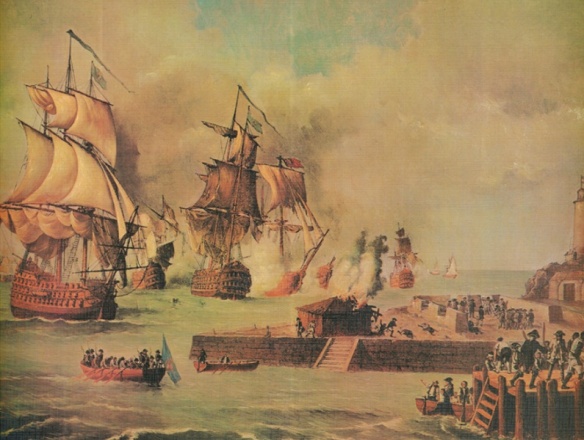British Admiral Edward “Old Grog” Vernon.
Unknown oil on canvas of Blas de Lezo.
Date March 14-May 20,1741
Forces British: 29 ships of the line, c. 150 other vessels; Spanish: 6 ships of the line
Losses British: 50 ships of all kinds; Spanish: 6 ships of the line
Location Cartagena de Indias, Colombia
When war broke out in October 1739, it was conceived by Britain as a formal naval war. The British navy was to use its numbers and capability to achieve decisive results at critical points within Spain’s vulnerable and vital maritime empire. British squadrons were well placed to begin the campaign. The small squadron at Jamaica had already been ordered to undertake reprisals. The Mediterranean squadron was reinforced and ordered to prevent the Cartagena and Cadiz squadrons from uniting with the squadron at Ferrol. Vice Admiral Edward Vernon had been sent to the West Indies to do what damage he could to the Spaniards. Rear Admiral Chaloner Ogle had a small force off St Vincent to intercept Spanish shipping. An expedition to disrupt Spanish commerce in the Pacific was prepared under Commodore George Anson, and in December 1739 it was agreed to send a large expedition of 12,000 soldiers to the Caribbean to achieve the decisive conquests that would force Spain to make peace.
The results were profoundly disappointing. The Cadiz and Ferrol squadrons evaded the British squadrons and sailed for the West Indies. The French Brest squadron of 18 line under the Marquis d’Antin and the Toulon squadron of 12 line under the Comte de La Roche-Alard also got out and sailed to the West Indies. The uncertainty about the intentions of these neutral French forces and their eventual escape increased the demands on the expeditionary force intended for the West Indies and imposed delay upon it. An escort of 25 line was required to take the expeditionary army to join Vernon’s six warships, but by the time the expedition arrived at Jamaica, d’Antin had decided to return to Brest. Despite what appeared to be overwhelming superiority, the attempts upon Cartagena de las Indias, Guantanamo Bay on Cuba and Panama were all failures. Only the little island of Roatan in the Bay of Honduras was seized and held before the remnants of the expeditionary force sailed for home in October 1742.
The success at Porto Bello in 1739 inspired the British to prey further upon Spain’s colonial possessions. A massive force, requiring a quarter of the entire strength of the Royal Navy, was sent to the Caribbean the following year. The death of the expedition’s overall commander, Lord Cathcart, en route left the naval force under Vice Admiral Edward Vernon, victor of Porto Bello, and the troops under Major-General Thomas Wentworth, with no one to arbitrate if they disagreed.
Britain’s target was Cartagena de Indias, the major port in Spanish-ruled New Grenada. Leading its defense was Admiral Bas de Lezo, one of Spain’s most gallant naval commanders, who had lost a leg, an arm, and an eye in a distinguished fighting career. He had only six ships of the line to face the British armada, but had no intention of giving in. The British arrived off the city in mid-March and settled down to a bombardment of its walls. The entrance to the harbor was defended by shore batteries and the guns of de Lezo’s six ships anchored inside. On April 15, the British attempted a sea and land assault on these defenses.
After a sharp fight de Lezo scuttled his ships to keep them out of British hands and fell back on the port’s inner fort. As time passed and tempers frayed, cooperation between Vernon and Wentworth broke down. Land assaults proved to be costly failures, while Vernon’s ships bombarding the walls came under damaging fire from shore guns.
Caribbean epidemic diseases raged, decimating naval crews and troops. After 67 fruitless days the British sailed away on May 20, burning some of their ships because they had no crews left to man them. De Lezo did not enjoy his triumph for long, dying of a wound sustained in the siege. The British government was embarrassed by this ignominious defeat because the operation had been prematurely hailed as a triumph and victory medals struck.
